Soul Calibur IV Review
Soul Calibur IV
Welcome back to the stage of history - anyone nostalgic about their Dreamcast is in for a serious treat.
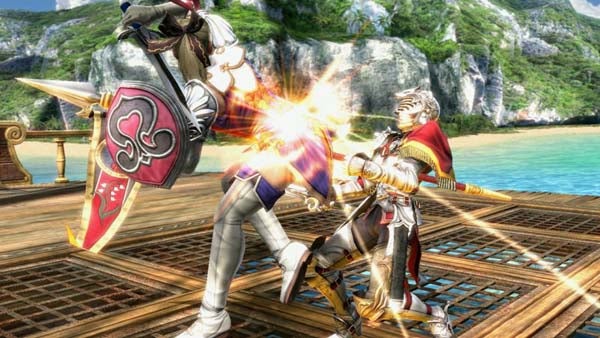
Verdict
Key Specifications
- Review Price: £39.99
Let’s face it, Soul Calibur IV was always going to struggle to make the same impact that the original did when it appeared at E3 in 1999. The fighting game that then made jaws drop around the world now feels as familiar and comfortable as a pair of old slippers. Once, Soul Calibur was the beat-em-up that redefined expectations of the genre and actually looked like it might rescue Sega’s doomed Dreamcast. Now a new version is looked forward to with about as much expectation as the average FPS. Can Soul Calibur IV turn things around? Can the series still deliver one more genre-redefining masterpiece?
After a few hours with Soul Calibur IV your answer will probably be “maybe not.” It’s not that Soul Calibur IV doesn’t push the boundaries at all – it’s undoubtedly the most beautiful and graphically advanced fighting game ever made – but like the last iterations of Tekken and Virtua Fighter it plays safe. While the fighting seems to take place in full 3D, you still have little control over movement outside of a straight 2D plane.
Despite the incorporation of the Havok physics engine, the arenas are no more interactive than they were in previous versions and there’s little evidence of any realistic location-by-location damage modelling going on. The eye candy might have moved on in leaps and bounds since Soul Calibur I, but the basic combat hasn’t. This isn’t the Resident Evil 4 or Half-Life 2 of fighting games; just a more gorgeous, more polished and more generous package of what we’ve already had before. On that, we should be clear.
But once you get past that slight disappointment, Soul Calibur IV is utterly fantastic.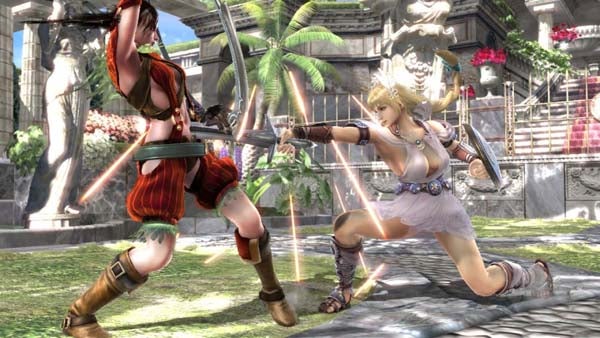
Let’s face it: that eye candy helps. I’m a little disappointed to see that Namco has taken a trip into the seedy Dead or Alive T&A district when it comes to character design – I’ve never seen so many female fighters who look like they’re on their way to a World of Warcraft-themed S&M party – but the amount of care and detail that has gone into the human (or inhuman) form, not to mention arms and armour, is frequently breathtaking.
I thought Ninety-Nine-Nights and Devil May Cry 4 had established new benchmarks for reflective breastplates, swords and shields, but Soul Calibur IV makes even that work look clumsy. The lighting and the use of post-processing techniques like focus blur gives the game an effect that’s part cinematic and part airbrush fantasy painting. And the animation is just plain awesome.
Lest we forget, this is a series that has always been known for its incredible backdrops, and Soul Calibur IV doesn’t disappoint. Battles are staged in palatial gardens, ancient halls and misty swamps where dodos waddle through the arena while hippos munch in the background. We get mountain shrines, Egyptian temples and pirate ships, not to mention icy wastes and weird baroque monuments that seem patterned after carousels. Needless to say, the classic fight on a drifting barge is back too. In all locations it’s hard to take in all the textures and colours or spot all the detail going on behind the action. Basically, beat-em-ups don’t get any better looking than this.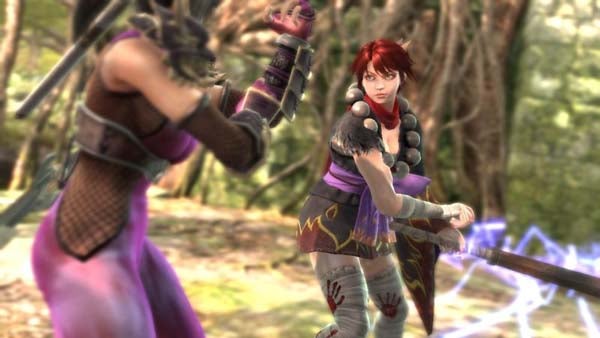
And you already know what Soul Calibur IV sounds like: the clash of steel on steel, the yelps and screams of battle, the powerful orchestral score and – above all else – that incredibly cheesy voiceover. I won’t spoil the pick of the lines for you here. All you need know is that fans of ridiculously overwrought commentary and bizarre motivation won’t be disappointed.
Who wrote this stuff? Does anyone know who the legendary voice narrating it belongs to? Does he speak like that when ordering takeaway? “Torn between Pork Chow Mein and Kung-Po Chicken, a warrior must cheat fate to embrace his destiny.” Enquiring minds want to know.
Yet Soul Calibur IV’s beauty goes way beyond being skin deep. We all know that the real meat of a fighting game lies in the multiplayer versus action, but in more recent versions of its beat-em-ups Namco has bent over backwards to add long-term depth for lonesome players. Soul Calibur IV still has your standard arcade mode, but the story mode is now something different, containing five rounds of single and multi-opponent challenges for each of the game’s thirty plus characters, each tale culminating in a climactic boss battle. 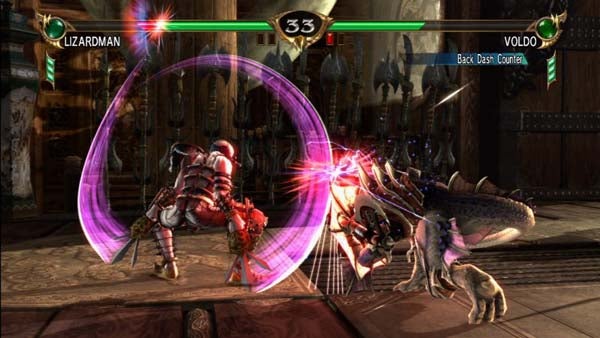
This in itself could keep you busy for some time, particularly as it’s the key to unlocking every character and costume item in the game’s extensive catalogue, but on top of this the game packs in an additional single-player campaign, Tower of Lost Souls. Here you ascend or descend the titular tower, with two or more floors making up a mission. You select a team of characters to complete each mission, and will have to defeat whatever opponent(s) each floor throws at you before your whole team is destroyed.
Not only are the tower missions tougher than the stages in the arcade or story modes, but they require a certain level of strategy. You’ll probably need a couple of goes at each mission before you crack who you need to fight and in what order. What’s more, as the next opponent on a floor enters the fray as soon as their predecessor has been defeated, it makes the game much less of a stop/start affair than single-player beat-em-ups tend to be. You can actually get into the flow of the action.
It’s in the story and Tower of Lost Souls modes (and not the more straightforward arcade mode) that skills come into play. Each character has their own set of skills, conferring on them the chance to counter some moves automatically, cause damage to a guarding opponent or even turn temporarily invisible. The further you get up – and even more so down – the tower, the more vital these skills become.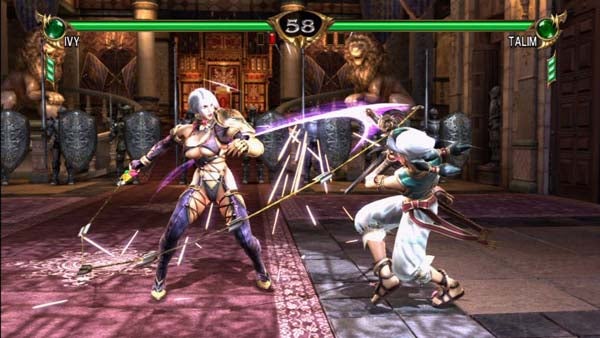
Yet this feature only really makes sense when you tie it into Soul Calibur IV’s other big enhancement: the new character customisation mode. You can create characters based on any of the Soul Calibur cast then tweak clothes, hairstyles and armour to your heart’s content, paying for new and improved items with the currency collected by playing the single player game (though some weapons and items may need to be unlocked first).
This would be fun, anyway, but in the end there’s no real point to playing a clone of, say, foxy female ninja Taki if she just plays like foxy female ninja Taki in a small bikini. However, by adding skills and custom weapons you can tweak your custom fighter in different directions and make them more useful to your Tower of Lost Souls missions. Indeed, the more you fight with one character (or a custom character based on them) the higher your rank goes in their style and the more skills you’ll have open for acquisition. The one feeds the other, as they say.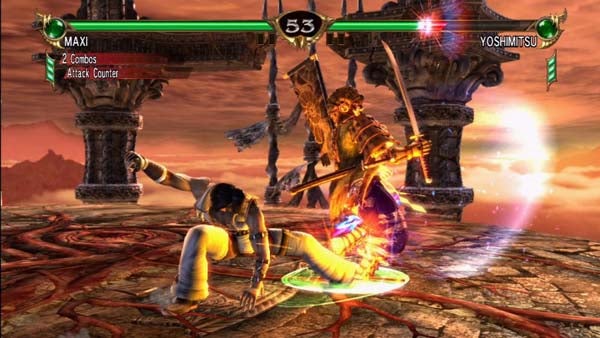
This all makes Soul Calibur IV a pretty rare thing: a fighting game you can play alone for more than a weekend and still get something out of it. In fact, Tower of Lost Souls can be hideously more-ish. At the same time, it’s a superb multi-player fighting game. It helps that the roster of characters is so extensive, and that the fighters are so different and so well balanced.
While, as in any fighting game, you can divide the heroes and villains up into basic types (quick and offensive, heavy hitters, slow tanks, evenly balanced) there’s still a surprising degree of differentiation between those types. Both Taki and Raphael, for example, specialise in high-speed, hard to defend attacks, but each has a different rhythm and style to how you play them. The emphasis on weapons also has a major effect, because the difference in range between, say, Hilde’s spear and Voldo’s knives necessitates different approaches.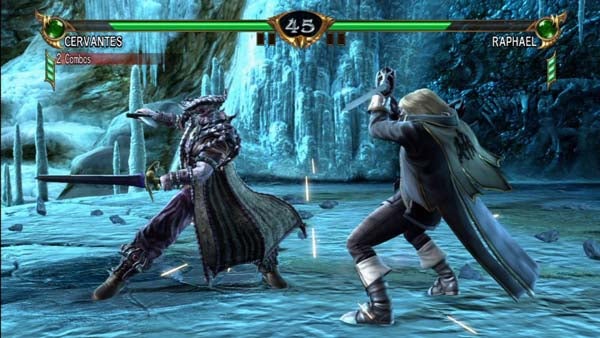
The other thing that helps the multi-player experience is that Soul Calibur IV is still a game where a certain amount of button-mashing goes a long way. In the single player game this can be to the game’s detriment, but it does mean that even novice players have a chance at unseating old hands in a winner stays on situation given a healthy dollop of jammy luck.
Interestingly, Soul Calibur IV also toughens things up for those wussy players who do nothing else but block. A new soul gauge under the health gauge turns from blue to red while players are guarding, and when it turns pure red a well timed attack can shatter armour, making the player more vulnerable for the rest of the match.
Sadly I’ve had little opportunity to test online play before release, but the little I have seen seems smooth and not seriously affected by lag or sudden frame-rate drops. Whether this remains the case after release remains to be seen, but given Namco’s success at making Tekken 5: Dark Resurrection work on PSN, I wouldn’t bet against it.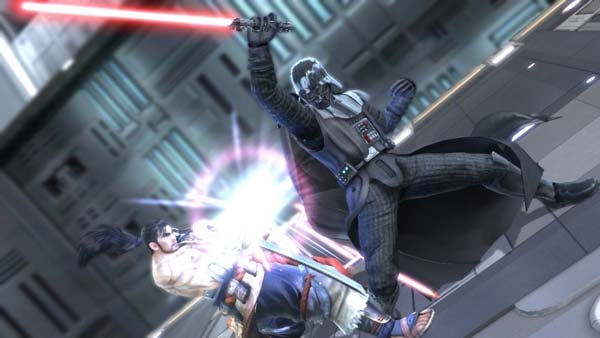
The icing on the cake – though some of the hype has made it seem like the filling too – is the introduction of Star Wars characters into the Soul Calibur world. Yes, the justification story-wise is every bit as spurious or non-existent as you might have feared, but it’s still cool to play as Yoda in the Xbox 360 version, even if he’s not quite as acrobatic as Episode II might have suggested. Darth Vader might be slightly less attractive, being slower moving and less responsive, but it’s still good to see him in action.
Both Vader and Yoda – not to mention their guest, the secret apprentice from the forthcoming Star Wars: The Force Unleashed – have limited force powers at their disposal. You won’t be tearing pillars down and flinging them at your foe, but you can hit them with force lightning as you hurl yourself into the fray.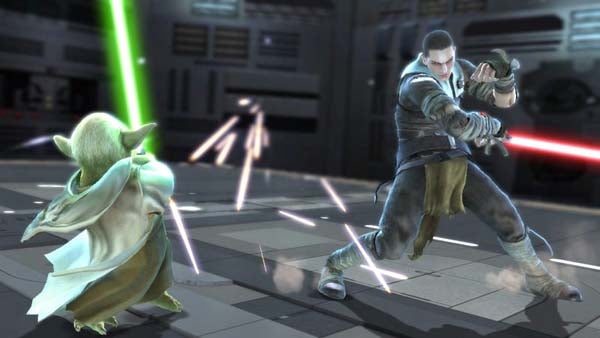
All in all, this isn’t a game that scores high for big or obvious revolutionary transformations, but the more you play it the more you realise that the generosity of the package and the huge number of small enhancements makes this the best Soul Calibur yet. Is it the best fighting game out there? Well, for me Virtua Fighter 5 pips it for the perfect precision and balance of its play mechanics, but there’s not an awful lot in it.
What I would say is that if you haven’t played a beat-em-up for a while, then this one has an excellent chance of reigniting your interest in the genre. It’s fast-paced, bold and beautiful, and the perfect way to spend a summer evening with a few beers, some pizza and some old mates.
”’Verdict”’
The ultimate Soul Calibur. In terms of the core gameplay there’s nothing revolutionary, but the new single-player modes and the character creation tools improve the experience in ways you might not expect. Get back to the stage of history and enjoy.
Trusted Score
Features
| Genre | Fighting |
| Player(s) | 2 |
| Online Multiplayer | With Online Multiplayer |

